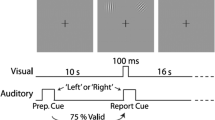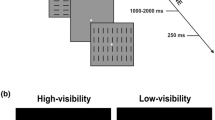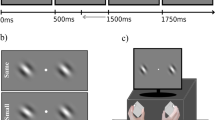Abstract
The existence of neural correlates of spatial attention is not limited to the reactive stage of stimulus processing: neural activities subtending spatial attention are deployed well ahead of stimulus onset. ERP evidence supporting this proactive (top-down) attentional control is based on trial-by-trial S1–S2 paradigms, where the onset of a directional cue (S1) indicates on which side attention must be directed to respond to an upcoming target stimulus (S2). Crucially, S1 onset trigger both attention and motor preparation, therefore, these paradigms are not ideal to demonstrate the effect of attention at preparatory stage of processing. To isolate top-down anticipatory attention, the present study used a sustained attention paradigm based on a steady cue that indicates the attended side constantly throughout an entire block of trials, without any onset of an attentional cue. The main result consists in the description of the attention effect on the visual negativity (vN) component, a growing neural activity starting before stimulus presentation in extrastriate visual areas. The vN was consistently lateralized in the hemisphere contralateral to the attended side, regardless of the hand to be used. At the opposite, the lateralized motor activity emerged long after, confirming that the hand-selection process followed the spatial attention orientation process. The present study confirms the anticipatory nature of the vN component and corroborate its role in terms of preparatory visuospatial attention.







Similar content being viewed by others
Data availability
Data and materials will be made available on request.
References
Berchicci M, Ten Brink AF, Quinzi F, Perri RL, Spinelli D, Di Russo F (2019) Electrophysiological evidence of sustained spatial attention effects over anterior cortex: possible contribution of the anterior Insula. Psychophysiology 57(7):e13369
Bianco V, Berchicci M, Perri RL, Spinelli D, Di Russo F (2017) The proactive self-control of actions: time-course of underlying brain activities. NeuroImage 156:388–393
Bianco V, Berchicci M, Quinzi F, Perri RL, Spinelli D, Di Russo F (2019a) Females are more proactive; males are more reactive: neural basis of the gender-related speed/accuracy trade-off in visuo-motor tasks. Brain Struct Funct 225:187–201
Bianco V, Perri RL, Berchicci M, Quinzi F, Spinelli D, Di Russo F (2019b) Modality-specific sensory readiness for upcoming events revealed by slow cortical potentials. Brain Struct Funct 225:149–159. https://doi.org/10.1007/s00429-019-01993-8
Bianco V, Berchicci M, Perri RL, Quinzi F, Mussini E, Spinelli D, Di Russo F (2020) Preparatory ERPs in visual, auditory and somatosensory discriminative motor tasks. Psychophysiology. https://doi.org/10.1111/psyp.13687
Birbaumer N, Elbert T, Canavan AG, Rockstroh B (1990) Slow potentials of the cerebral cortex and behavior. Physiol Rev 70(1):1–41
Bonnefond M, Jensen O (2015) Gamma activity coupled to alpha phase as a mechanism for top-down controlled gating. PLoS ONE 10(6):e0128667
Braver TS (2012) The variable nature of cognitive control: a dual mechanisms framework. Trends Cognit Sci 16(2):106–113
Casteau S, Smith DT (2018) Covert attention beyond the range of eye-movements: evidence for a dissociation between exogenous and endogenous orienting. Cortex. https://doi.org/10.1016/j.cortex.2018.11.007122,170-186
Corbetta M, Shulman GL (2002) Control of goal-directed and stimulus driven attention in the brain. Nat Rev Neurosci 3:201–215
Dale CL, Simpson GV, Foxe JJ, Luks TL, Worden MS (2008) ERP correlates of anticipatory attention: spatial and non-spatial specificity and relation to subsequent selective attention. Exp Brain Res 188:45–62
Di Russo F, Pitzalis S (2013) EEG-fMRI combination for the study of visual perception and spatial attention. Cognitive electrophysiology of attention: signals of the mind. Academic Press, London, pp 58–70
Di Russo F, Berchicci M, Bozzacchi C, Perri RL, Pitzalis S, Spinelli D (2017) Beyond the “Bereitschaftspotential”: action preparation behind cognitive functions. Neurosci Biobehav Rev 78:57–81
Di Russo F, Berchicci M, Bianco V, Perri RL, Pitzalis S, Quinzi F, Spinelli D (2019) Normative event-related potentials from sensory and cognitive tasks reveal occipital and frontal activities prior and following visual events. NeuroImage 196:173–187
Di Russo F, Berchicci M, Bianco V, Perri RL, Pitzalis S, Mussini E (2020) Modulation of anticipatory visuospatial attention in sustained and transient tasks. Cortex
Eimer M (1993) Spatial cueing, sensory gating and selective response preparation: an ERP study on visuo-spatial orienting. Electroencephalogr Clin Neurophysiol Evoked Potent Sect 88(5):408–420
Eimer M, Van Velzen J (2002) Crossmodal links in spatial attention are mediated by supramodal control processes: evidence from event-related potentials. Psychophysiology 39(4):437–449
Eimer M, van Velzen J, Driver J (2002) Cross-modal interactions between audition, touch, and vision in endogenous spatial attention: ERP evidence on preparatory states and sensory modulations. J Cognit Neurosci 14(2):254–271
Eimer M, van Velzen J, Forster B, Driver J (2003) Shifts of attention in light and in darkness: an ERP study of supramodal attentional control and crossmodal links in spatial attention. Cognit Brain Res 15(3):308–323
Eimer M, Forster B, Van Velzen J, Prabhu G (2005) Covert manual response preparation triggers attentional shifts: ERP evidence for the premotor theory of attention. Neuropsychologia 43:957–966
Eimer M, Van Velzen J, Gherri E, Press C (2006) Manual response preparation and saccade programming are linked to attention shifts: ERP evidence for covert attentional orienting and spatially specific modulation of visual processing. Brain Res 1105:7–19
Elbert T, Rockstroh B (1987) Threshold regulation-a key to the understanding of the combined dynamics of EEG and event-related potentials. J Psychophysiol 1(3):317–333
Flores AB, Digiacomo MR, Meneres S, Trigo E, Gómez CM (2009) Development of preparatory activity indexed by the contingent negative variation in children. Brain Cogn 71(2):129–140
Gómez CM, Fernández A, Maestú F, Amo C, Gonzalez-Rosa JJ, Vaquero E, Ortiz T (2004) Task-specific sensory and motor preparatory activation revealed by contingent magnetic variation. Cognit Brain Res 21(1):59–68
Gómez CM, Flores A, Ledesma A (2007) Fronto-parietal networks activation during the contingent negative variation period. Brain Res Bull 73:40–47
Gonçalves FG, Rego G, Conde T, Leite G, Carvalho S, Lapenta OM, Boggio PS (2018) Mind wandering and task-focused attention: ERP correlates. Sci Rep 8(1):7608
Harter MR, Miller SL, Price NJ, LaLonde ME, Keyes AL (1989) Neural processes involved in directing attention. J Cognit Neurosci 1(3):223–237
Hillyard SA, Anllo-Vento L (1998) Event-related brain potentials in the study of visual selective attention. PNAS 95(3):781–787
Hopf JM, Mangun GR (2000) Shifting visual attention in space: an electrophysiological analysis using high spatial resolution mapping. Clin Neurophysiol 111:1241–1257
Hopfinger JB, Buonocore MH, Mangun GR (2000) The neural mechanisms of top-down attentional control. Nat Neurosci 3(3):284–291
Kastner S, Ungerleider LG (2000) Mechanisms of visual attention in the human cortex. Annu Rev Neurosci 23(1):315–341
Kastner S, Pinsk MA, De Weerd P, Desimone R, Ungerleider LG (1999) Increased activity in human visual cortex during directed attention in the absence of visual stimulation. Neuron 22(4):751–761
Kinsbourne M (1987) Mechanisms of unilateral neglect. In: Advances in psychology, vol. 45, pp 69–86. North-Holland
Kornhuber HH, Deecke L (1965) Hirnpotentialänderungen bei Willkürbewegungen und passiven Bewegungen des Menschen: Bereitschaftspotential und reafferente Potentiale. Pflüger’s Archiv für die gesamte Physiologie des Menschen und der Tiere 284(1):1–17
Lucci G, Berchicci M, Perri RL, Spinelli D, Di Russo F (2016) Effect of target probability on pre-stimulus brain activity. Neuroscience 322:121–128
Luck SJ, Gaspelin N (2017) How to get statistically significant effects in any ERP experiment (and why you shouldn’t). Psychophysiology 54(1):146–157
Luck SJ, Chelazzi L, Hillyard SA, Desimone R (1997) Neural mechanisms of spatial selective attention in areas V1, V2, and V4 of macaque visual cortex. J Neurophysiol 77(1):24–42
Mangun GR, Hillyard SA (1991) Modulations of sensory-evoked brain potentials indicate changes in perceptual processing during visual-spatial priming. J Exp Psychol Hum Percept Perform 17:1057–1074
Martinez A, Anllo-Vento L, Sereno MI, Frank LR, Buxton RB, Dubowitz DJ, Hillyard SA (1999) Involvement of striate and extrastriate visual cortical areas in spatial attention. Nat Neurosci 2(4):364–369
Mesulam MM (1981) A cortical network for directed attention and unilateral neglect. Ann Neurol 10(4):309–325
Nobre AC, Sebestyen GN, Miniussi C (2000) The dynamics of shifting visuospatial attention revealed by event-related potentials. Neuropsychologia 38:964–974
Parr T, Friston KJ (2019) Attention or salience? Curr Opin Psychol 29:1–5
Pascual-Marqui RD (2002) Standardized low-resolution brain electromagnetic tomography (sLORETA): technical details. Methods Find Exp Clin Pharmacol 24:5–12
Pascucci D, Hervais-Adelman A, Plomp G (2018) Gating by induced Α-Γ asynchrony in selective attention. Hum Brain Mapp 39(10):3854–3870
Perri RL, Berchicci M, Lucci G, Cimmino RL, Bello A, Di Russo F (2014) Getting ready for an emotion: specific premotor brain activities for self-administered emotional pictures. Front Behav Neurosci 8:197
Perri RL, Berchicci M, Lucci G, Spinelli D, Di Russo F (2015) The premotor role of the prefrontal cortex in response consistency. Neuropsychology 29(5):767
Praamstra P, Boutsen L, Humphreys GW (2005) Frontoparietal control of spatial attention and motor intention in human EEG. J Neurophysiol 94:764–774
Ragazzoni A, Di Russo F, Fabbri S, Pesaresi I, Di Rollo A, Perri RL, Barloscio D, Bocci T, Cosottini M, Sartucci F (2019) “Hit the missing stimulus” A simultaneous EEG-fMRI study to localize the generators of endogenous ERPs in an omitted target paradigm. Sci Rep 9(1):3684
Rihs TA, Michel CM, Thut G (2009) A bias for posterior α-band power suppression versus enhancement during shifting versus maintenance of spatial attention. Neuroimage 44(1):190–199
Rizzolatti G, Riggio L, Dascola I, Umiltá C (1987) Reorienting attention across the horizontal and vertical meridians: evidence in favor of a premotor theory of attention. Neuropsychologia 25(1):31–40
Rockstroh B (1989) Slow cortical potentials and behav. Urban & Schwarzenberg.
Salmaso D, Longoni AM (1985) Problems in the assessment of hand preference. Cortex 21(4):533–549
Sheliga BM, Riggio L, Rizzolatti G (1994) Orienting of attention and eye movements. Exp Brain Res 98(3):507–522
Shibasaki H, Hallett M (2006) What is the Bereitschaftspotential? Clin Neurophysiol 117(11):2341–2356
Simpson GV, Weber DL, Dale CL, Pantazis D, Bressler SL, Leahy RM, Luks TL (2011) Dynamic activation of frontal, parietal, and sensory regions underlying anticipatory visual spatial attention. J Neurosci 31(39):13880–13889
Slagter HA, Prinssen S, Reteig LC, Mazaheri A (2016) Facilitation and inhibition in attention: functional dissociation of pre-stimulus alpha activity, P1, and N1 components. Neuroimage 125:25–35
Smith DT, Schenk T (2012) The Premotor theory of attention: time to move on? Neuropsychologia 50(6):1104–1114
Stuss DT, Murphy KJ, Binns MA (1999) The frontal lobes and performance variability: evidence from reaction time. J Int Neuropsychol Soc 5:123
Stuss DT, Murphy KJ, Binns MA, Alexander MP (2003) Staying on the job: the frontal lobes control individual performance variability. Brain 126(11):2363–2380
Van der Lubbe RH, Abrahamse EL (2011) The premotor theory of attention and the Simon effect. Acta Physiol (Oxf) 136(2):259–264
Van der Lubbe RH, Wauschkuhn B, Wascher E, Niehoff T, Kömpf D, Verleger R (2000) Lateralized EEG components with direction information for the preparation of saccades versus finger movements. Exp Brain Res 132(2):163–178
Van der Lubbe RH, Neggers SF, Verleger R, Kenemans JL (2006) Spatiotemporal overlap between brain activation related to saccade preparation and attentional orienting. Brain Res 1072(1):133–152
Van Velzen J, Forster B, Eimer M (2002) Temporal dynamics of lateralized ERP components elicited during endogenous attentional shifts to relevant tactile events. Psychophysiology 39(6):874–878
Van Velzen J, Gherri E, Eimer M (2006) ERP effects of movement preparation on visual processing: attention shifts to the hand, not the goal. Cogn Process 100:101
Funding
This study has been supported by operating funds of the University of Rome “Foro Italico” and of the Santa Lucia Foundation of Rome.
Author information
Authors and Affiliations
Corresponding author
Ethics declarations
Ethical standards
The study was performed in accordance with the ethical standards of the 1964 Declaration of Helsinki and its later amendments.
Conflict of interest
The authors declare that they no conflict of interests.
Ethical approval
The study was approved by the Ethics Committee of the Santa Lucia Foundation (approval number CE/PROG.521).
Consent to participate
Written informed consent to the study participation was obtained from all individual participants included in the study.
Consent for publication
Written informed consent for publication was obtained from all individual participants included in the study.
Additional information
Publisher's Note
Springer Nature remains neutral with regard to jurisdictional claims in published maps and institutional affiliations.
Rights and permissions
About this article
Cite this article
Di Russo, F., Berchicci, M., Bianco, V. et al. Sustained visuospatial attention enhances lateralized anticipatory ERP activity in sensory areas. Brain Struct Funct 226, 457–470 (2021). https://doi.org/10.1007/s00429-020-02192-6
Received:
Accepted:
Published:
Issue Date:
DOI: https://doi.org/10.1007/s00429-020-02192-6




